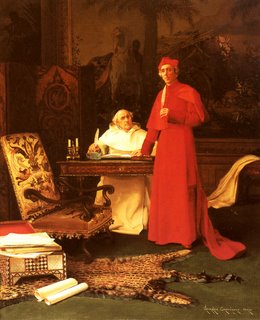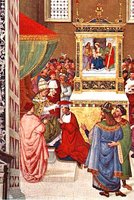The Cardinal's New Clothes et al...
 Station at the Church of the Holy Cross in Jerusalem
Station at the Church of the Holy Cross in JerusalemToday's Station in Rome is made at that great basilica built by St Helena that represents in the heart of Rome, Jerusalem and all the holy places of Our Lord's life. The church actually stands on the site of Helena's own palace on Mount Coelius, called the Sessorian mansion. She had brought back relics of the true cross, the title above Our Lord's head and other relics from Jerusalem and converted her own home into a church.
It is quite appropriate on Mothering Sunday that we remember St Helena, mother of the emperor Constantine and also in holding the Station at this church, we remember Jerusalem, in a sense, the Mother Church from which the apostles were sent out. The presence of Jerusalem in Rome, through this basilica, unites and emphasises the roots of Our Holy Mother, the Church, whence this day gets its name in English ecclesiastical tradition.
Today is also Laetare Sunday, the mid-Lent Sunday set aside for rejoicing in the victory of the Cross - which is found in the Stational church - and associated with roses - once fashioned from gold. The links above have more information about the customs associated with this day as does this post from Daniel Mitsui. These themes of motherhood, roses and joy are reflected in yesterday's post on the Solemnity of the Annunciation.
I also mentioned last week the great Lenten Gospels taken from St John which are read to the catechumens who are approaching the baptismal joy of Easter. Today's Gospel is that of Christ healing the Man Born Blind (Jn 9:1-41)... and the prayer below is taken from the Prayer over the Catechumens at their Second Scrutiny today.

However, what I would like to post about today, on a slightly more frivolous note but befitting recent events in Rome, is some trivia about cardinalatial symbols and vesture, especially as the cardinal's red hat and outfit elicits such excitement! I suppose this is a fitting diversion for Laetare Sunday, especially following on from the Mass of the Rings celebrated yesterday by Pope Benedict XVI with his 15 new cardinals,). At that Mass the Holy Father gave each of the new cardinals a ring that is a symbol of their office within the Church; Rocco Palmo has already posted something about this and you can read his very informative post here. Moreover, I think it's quite appropriate to talk about vesture and matters sartorial on this day, since many a sartorially-minded priest would specially don a rose-coloured vestment today! This is my 'tribute' to them. Don Jim Tucker, are you reading?!
What follows is an entertaining (and amusing) account by H. V. Morton about the sartorial symbols that traditionally attended a cardinal and expressed his dignity within the Church. The book was written in 1957 but it is still broadly applicable today:

"More than most men, priests must be the despair of their tailors: those rusty cassocks and old hats, those broad-toed unpolished shoes! Possibly St Jerome's savage attack on fashionable fifth-century priests with their curled and scented locks, walking on tip-toe lest they should soil their feet, may have had a chilling effect ever since on any latent Brummellism in the Church. Though, if anyone wishes to see how smart a priest could look, he should go to Gammarelli and the other ecclesiastical outfitters in the Piazza della Minerva, not far from the Pantheon.
This is the Savile Row of ecclesiastical Rome. The windows display a fine selection of sombre hats, an occasional mitre, birettas, little cloth-covered violet and red buttons, braids and pipings of various colours, strong shoes that look as if they might inflict a mighty kick on the devil, and those beautifully made skull caps, white for the Pope, red for a Cardinal, purple for a bishop, and black for ordinary priests, known as the zucchetto...
I have always thought the most romantic of all headgear is the red hat of a Cardinal. [He means the galero, now sadly all but extinct] This remarkable object sails majestically through history and art. In Rome you see it, old and dusty, hanging, many-tasseled, from the arches of a titular church to which it has been bequeathed by its owner. I looked in vain for a red hat in the windows of these shops, and was told it is not an article which is kept in stock, but it is made only to order. I was also told that Cardinal's hats are not what they once were [indeed!]. They are now merely symbols and are never worn: the crown has almost ceased to exist and the famous hat is nothing more than a wide, stiff brim from which to hang fifteen tassels. Nevertheless they cost £20 each [about £350 today]. There is a story that Cardinals owe their hats to a woman, the Countess of Flanders, who at the Council of Lyons in 1145 complained that she could not distinguish the Cardinals in their mitres from abbots and other great persons, for their distinctive dress had not yet developed. From the time of Boniface VIII in 1297, the colour worn by Cardinals was royal purple, but in 1464 Paul II, who loved to surround himself with magnificence, put the Sacred College into scarlet, though Cardinals still wear purple in Lent and Advent, and during a Conclave [This is also sadly abrogated]. At such times you can tell a Cardinal from a Bishop only by his red zucchetto and red stockings. John Evelyn was told in Rome that the Jews used to wear red hats by order until one day a short-sighted Cardinal saluted one of them, thinking him a fellow member of the Sacred College, after which the Jews were made to wear yellow!
When discussing the dress of a Cardinal, the manner of the ecclesiastical outfitter becomes hushed and reverent, much as a military tailor must contemplate, even in these informal days, the full dress uniform of a field marshal. Of all the members of the Roman Church, the Pope not excepted, the Cardinal is the most dressy and has the largest wardrobe. His everyday costume is a black soutane and short black cape edged with scarlet piping, scarlet cloth-covered buttons and scarlet buttonholes. With this he wears a scarlet sash and stock - which is the right name for that flash of colour beneath a clerical collar - and scarlet stockings. Out of doors he wears an ordinary priest's hat trimmed with red silk ribbon and with fifteen gold tassels. In formal dress a Cardinal wears a full cloak of scarlet silk over his black soutane, and on state occasions his soutane is scarlet, worn with a lace rochet and a short round cape called a mantelletta, which opens for the arms.He needs an even more sumptuous outfit for papal functions, corresponding to court dress. This is a scarlet soutane with a train, a lace rochet, and a large circular scarlet silk cloak cut like an ancient Roman paenula, which is drawn up over the arms in front and spreads out behind into a long train called the cappa magna. This cape has a hood of scarlet silk (covered with ermine for warmth from October 25 to April 25), and in the days when the red hat was worn, it was put on over his hood, as seen in old portraits. The skull cap, the biretta, the stockings and gloves are all scarlet.
Cardinals today are no longer millionaires, neither do they drive about in the heavy coaches drawn by black stallions which were such a notable feature of Roman streets a century or so ago; but they have the status of princes. In Roman society it is customary for a Cardinal to be met at the foot of the stairs by servants with lighted candles, who escort him to the reception rooms and wait to precede him, when he leaves, to his car. A Cardinal's dwelling, no matter how humble, is still his 'palace', and he is entitled to keep a throne there, but it must face the wall and may never be used except when the Pope is dead and before his successor has been elected. There are about ten days during an interregnum in which a Cardinal can turn his throne around and sit in it before he attends the Conclave..."
Let us pray with and for those who are to be baptised this Easter that everything we do (and whatever we wear) gives glory to God who has opened the eyes of our heart:
you are the true light that enlightens the world.
Through your Spirit of truth
free those who are enslaved by the father of lies.
Stir up the desire for good in these elect,
whom you have chosen for your sacraments.
Let them rejoice in your light, that they may see,
and, like the man born blind whose sight you restored,
let them prove to be staunch and fearless witnesses to the faith,
for you are Lord forever and ever."
Amen.









7 Comments:
I see you found a photo of newly cappa-ed Cardinal Sean O'Malley, Archbishop of Boston, to provide an image of the red garb of the princes of the Church. And, boy, does he look happy sporting it for the first time! Seeing that he received his hat only 48 hours ago, the wonder and responsibility of the title may just be beginning to sink in for him. This is a man who has risen to prominence in the Church quite quickly and for truly unenviable service, mostly dealing with navigating the shoals of the sexual abuse scandal among the clergy in various dioceses in the U.S. My prayers follow him, his brothers in the College of Cardinals, and all his fellow bishops, who have offered their lives in service to the people of God.
Hmm...
I like the change of tack at the end of that post!!!
Slightly off topic, but I have been wondering about something since you last posted on your 'habit' - if the (rather large) Rosary is worn under all those layers of clothing - how do you use it?
I guess I was concerned that a Rosary was being used as a form of dress rather than as a device to be used!
Just asking....
The Rosary we wear contains fifteen decades and I most certainly use it. It's so wonderful to have the Rosary hanging by my side and I use it when I walk from place to place, finger it to remind me of Mary's presence and I often clasp the Crucifix in my hand.
The Rosary is worn in such a way that it hangs on our left side; no garments are in the way.
The photo here shows how accessible it is.
Thanks for asking!
Hey, thanks for answering! It may have been dumb, but I literally wondered about this briefly every day for quite a few weeks and I just had to ask.
BTW, I do enjoy your Blog and have added you to my Blogroll so others may do the same.
Thank you for your kind comments and for adding me to your blogroll.
God bless.
If this book was published in 1957 one detail was anachronistic even then. The train of the prelatial choir cassock was abolished in 1952, at the same time the length of the cappa was shortened.
A good place to remind people of the wonderful remark of Blessed Pope John: "Un po di vanita fa bene alla Chiesa".
Post a Comment
<< Home